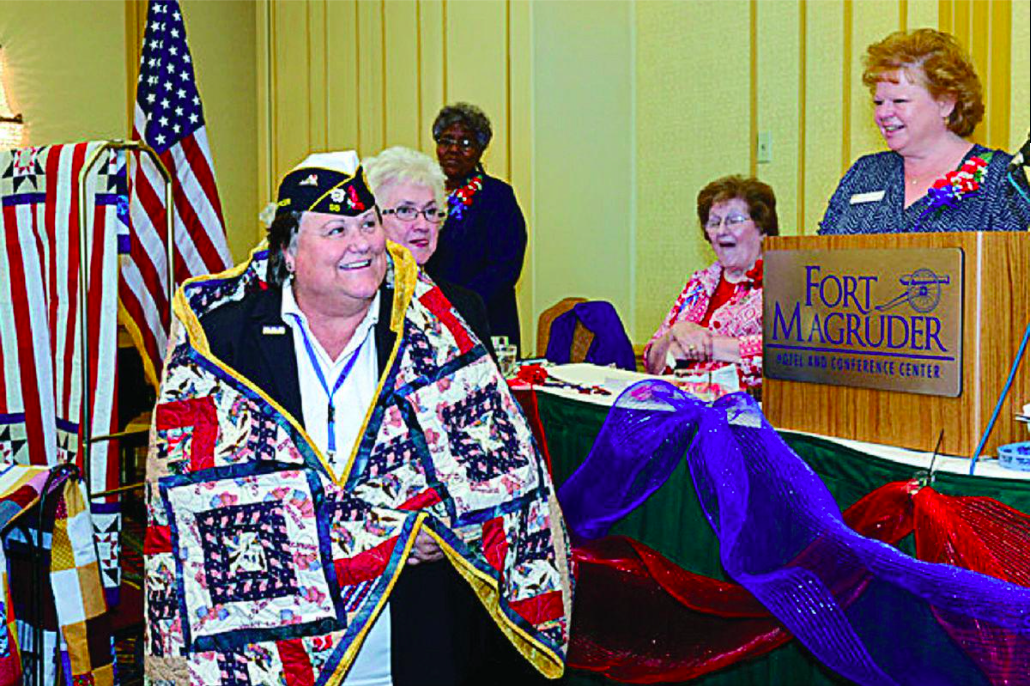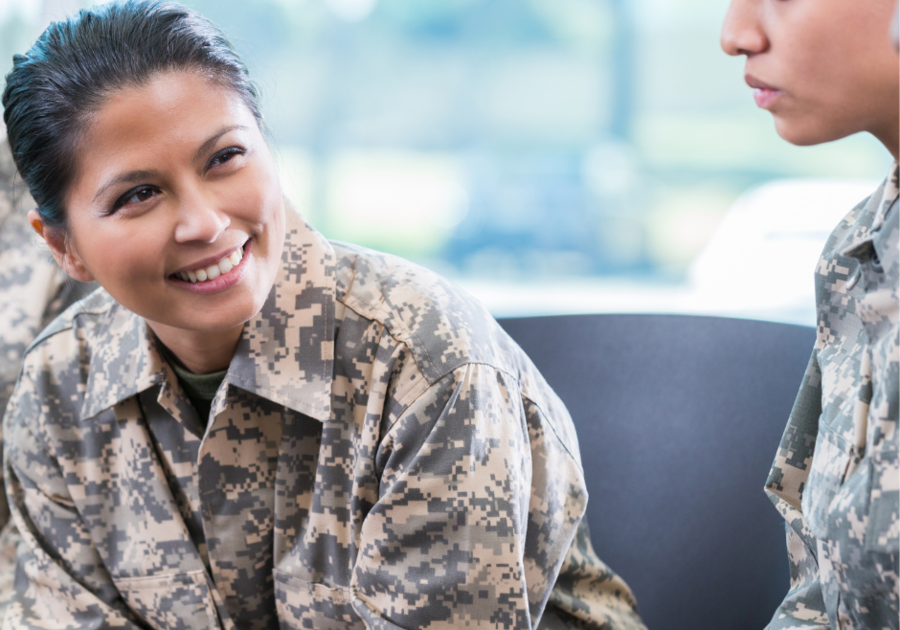This is the third installment in a series of four articles honoring Women’s History Month and celebrating the contributions of women to historic and modern Fredericksburg. Last week, we highlighted women who have played prominent leadership roles in Fredericksburg history. This week, we are featuring women veterans in honor of the fifth annual Virginia Women Veterans Week, initiated by former Gov. Ralph Northam (D-VA) in 2018 . State officials say the Commonwealth of Virginia is home to more women veterans per capita than any other state in the country. Gov. Glenn Youngkin (R-VA) has highlighted that more than 109,000 women who have served in the military call Virginia home, and that women veterans are the fastest-growing segment of Virginia’s veteran population.
This week, we had the pleasure of speaking with Ms. Rita Chandler (MBA, ASO), Director of Women’s Outreach for the 2021-2022 Veterans Affairs & Rehabilitation Committee and former Commander of the American Legion Post 55 in the City of Fredericksburg. Chandler has been recognized as the second female Vice Commander (credited for bringing in the Eastern region at 100% membership for more than 107,000 women veterans in the Commonwealth of Virginia) (2013); as well as the first female accredited post Service Officer (2005-present) and first female Commander for the American Legion Post 55. Chandler volunteers in processing nearly 300 complex VA claims per year, approximately half of which are on behalf of women. Alongside Ms. Karen LeMaster Krizov (RN, Service Officer, retired member of the U.S. Navy Nurse Corps), Chandler facilitates educational workshops throughout the state on U.S. military history.
Below is a slightly abridged transcript of their recent seminar entitled, America’s Military Women: Our History and Our Challenges. Please note that the presentation is undergoing revision to reflect current statistics, as shared, for example, in the DoD Fiscal Year 2020 Annual Report on Sexual Assault in the Military.
“From the American Revolution through the Spanish American War in 1898, the vast majority of women served the American Military as nurses, although we all know of exceptions like Molly Pitcher - women who posed as men in order to fight for their country.
Women also served as water bearers, cooks, laundresses, couriers, saboteurs, and spies.
In 1866, Civil War Physician Dr. Mary Edwards Walker received the Medal of Honor [for tending the wounded in the aftermath of the Battle of Fredericksburg]. She is the only woman ever to receive the nation’s highest military honor.
Before the end of the Spanish American War, 1,500 civilian contract nurses are assigned to Army hospitals in the United States, Hawaii, Cuba, Puerto Rico, Guam, and the Philippines, as well as to the hospital ship, Relief. Twenty of those nurses die for their country.
In 1908, the Navy Nurse Corps was established. These women were considered volunteers, and not as Veterans, for their service.
In 1917, World War I arrives. During the course of the war, 21,480 Army nurses serve in military hospitals in the United States and overseas. The Army recruits and trains 233 bilingual telephone operators to work at switchboards near the front in France and sends 50 skilled photographers to France to work with the Quartermaster Corps. The Navy enlists 11,880 women as Yeomen (F) to serve stateside in shore billets and release sailors for sea duty. More than 1,476 Navy nurses serve in military hospitals stateside and overseas. Two women serve with the Coast Guard. The Marine Corps enlists 305 Marine (F) to ‘free men to fight’ by filling positions such as clerks and telephone operators on the home front.
During World War II, more than 400,000 American military women served at home and overseas, nearly all in non-combat roles. More than 60,000 Army nurses serve stateside and overseas during World War II. More than 150,000 women serve as WACs during the war; thousands are sent to the European and Pacific theaters. Before the war is over, more than 80,000 WAVES fill shore billets in communications, intelligence, supply, medicine, and administration. Marine Corps Women’s Reserve was created in 1943. Marine women serve stateside as clerks, cooks, mechanics, drivers, and in a variety of other positions. The Coast Guard establishes their Women’s Reserve known as SPARs in 1942. SPARs are assigned stateside and serve as storekeepers, clerks, photographers, pharmacist’s mates, cooks, and in numerous other jobs.
In 1942, 67 Army nurses are captured by the Japanese in the Philippines and are held as prisoners-of-war (POWs) for over two and a half years. More than 14,000 Navy nurses serve stateside, overseas on hospital ships, and as flight nurses during the war. Five Navy nurses were also captured by the Japanese on the island of Guam and held as POWs for five months before being exchanged.
On February 23, 1945, Vice Admiral Kinkaid welcomed home 11 other Navy Nurses (and 3 civilian nurses) captured on Bataan. The fourteen were rescued from captivity when American paratroopers and Filipino guerrillas subdued the prison garrison where they had been held for 37 months. The eleven Navy nurses were awarded the Bronze Star by the U.S. Army, and a Gold Star in lieu of a second Bronze Star by the Navy.
Soon after, the Women Air Force Service Pilots (WASPs) were organized to fly as civil service pilots. WASPs fly stateside missions as test pilots, transport pilots, and anti-aircraft artillery trainers.
In 1948, President Harry Truman signed The Women’s Armed Services Integration Act of 1948, giving women permanent status in the Army, Navy, Air Force, and Marine Corps. No longer would special women’s ‘components’ be formed during military emergencies for the duration only. Women in all the services were members of the Regular Armed Forces and the Reserves, subject to military authority and regulations and entitled to veterans’ benefits. In the same year, he also issued Executive Order 9881 ending racial segregation in the armed services.
The law also granted the service Secretaries authority to discharge women without specified cause and restricted women from flying aircraft engaged in combat and from being assigned to ships engaged in combat.
During the Vietnam War (1965-1975), some 7,000 American military women serve in Southeast Asia, the majority of them nurses. An Army nurse is the only US military woman to die from enemy fire in Vietnam. 1LT Sharon of the 312th Evac Hospital in Chu Lai South Vietnam when it came under fire.
Few people today understand the difficulties faced and personal sacrifices required of servicewomen of past eras who elected to serve their country in a military capacity. Women served when duty assignments and promotion potential were severely limited; when family responsibilities and military careers were not compatible; when women were not entitled to veteran benefits men took for granted; when women serving overseas were not provided with legal protection in the event of their capture by the enemy; and when women who died in the line of duty were not entitled to military burial.
An Air Force flight nurse died when the C-5A Galaxy Transport evacuating Vietnamese orphans she was aboard crashed on takeoff. Six other American military women die in the line of duty. During the Vietnam era, women began to break important barriers in the military.
In 1972, the Reserve Officer Training Corps (ROTC) is opened to Army and Navy women.
In 1976, women are admitted to the Service Academies. The WACs, WAVEs, WAFs, SPARs, and Women Marines disappear as women are fully integrated into the mainstream of their respective services.
In 1983, approximately 200 Army and Air Force women are among the forces deployed to Grenada on Operation Urgent Fury. Women serve on air crews, as military police, and as transportation specialists.
In 1986, six Air Force women serve as pilots, copilots, and boom operators on the KC-135 and KC-10 tankers that refuel FB-111s during the raid on Libya.
In 1989, 770 women deploy to Panama in Operation Just Cause. Two women command Army companies in the operation and three women Army pilots are nominated for Air Force Medals. Two receive the Air medal with ‘V’ device for participation in a combat mission.
In 1990-1991, some 40,000 American military women are deployed during Operations Desert Shield and Desert Storm. Two Army women are taken prisoner by the Iraqis. As the 1990s military deployments were soon to demonstrate, having a non-combat MOS (Military Occupational Speciality) did not guarantee that an individual would not find herself in a combat area or exposed to danger in the course of performing her assigned duties.
On September 11, 2001, the attack at the Pentagon left 125 people killed on the ground and 59 passengers killed. Ten active duty, reserve, and retired servicewomen were among the casualties. Servicewomen were activated and deployed in support of the War on Terrorism.
In 2002, an enlisted woman Marine is killed in an aircraft crash in Pakistan, the first woman to die in Operation Enduring Freedom, part of the Global War on Terror.
By the end of 2004, 19 servicewomen have been killed as a result of hostile action during the War in Iraq. This marks the most servicewomen to have died as a result of hostile action in any war that the nation had participated in.
In 2005, Army National Guard SGT Ann Hester of 617 MP in Baghdad, Iraq became the first woman in history awarded the Silver Star for combat action. She is now one of 14 women in U.S. history to have received the medal.
In the largest single deployment of women in US military history, with widespread public support, 41,000 military women made up seven percent of the US Armed Forces in the Persian Gulf. Women served as aircraft pilots carrying troops and supplies; deployed on reconnaissance missions; served aboard hospital ships, in mobile medical units, and in field hospitals; crewed planes and helicopters; directed artillery, drove trucks, ran prisoner-of-war facilities; served in port security units, in military police units, and as perimeter guards; and performed a myriad of communications, intelligence, supply and administrative jobs necessary for military success in the Persian Gulf.
The most striking aspect of the Pentagon’s 2013 decision to lift a 1994 ban on combat duty for women was the lack of any substantive opposition in Congress. That’s partly because the new policy reflects the actual practice in the field in Iraq and Afghanistan. It also gives belated acknowledgment to the over 150 women who have died in uniform since 2001. They did, in fact, perish in combat, according to a January 27, 2013 story released by the Boston Globe. But that’s not the end of the story.
Although combat roles are now theoretically open to women, the Services had until January 2016 to identify certain roles from which women should be excluded. Women have been previously restricted from serving in the following positions:
Army: Infantry, armor, special forces, combat engineer companies, and ground surveillance radar platoons.
Air Force: Para-rescue, combat controllers, and those units and positions that routinely co-locate with direct ground combat units.
Navy: Submarines, coastal patrol boats, mine warfare ships, SEAL (special forces) units, joint communications units that co-locate with SEALs, and support positions (such as medical, chaplain, etc.) co-located with Marine Corps units that are closed to women.
Marine Corps: Infantry regiments and below, artillery battalions and below, all armored units, combat engineer battalions, reconnaissance units, riverine assault craft units, low altitude air defense units, and fleet anti-terrorism security teams.
Coast Guard: none.
Today’s Challenges
Anu Bhagwati, a former Company Commander in the Marines and Executive Director of Service Women’s Action Network, a veterans advocacy group, says she sees a pattern of the military using psychiatric diagnoses to get rid of women who report sexual assaults.
‘It’s convenient to sweep this under the rug. It’s also convenient to slap a false diagnosis on a young woman…and then just get rid of them so you don’t have to deal with that problem in your unit. And, unfortunately, a lot of sexual assault survivors are considered problems…’
Military records show the personality disorder diagnosis is being used disproportionately on women. By Yale Law School’s Veterans Legal Services Clinic under a Freedom of Information Act request: ‘In the Army, 16% of all soldiers are women, but females constitute 24% of all personality disorder discharges. In the Air Force, women make up 21% of the ranks and 35% of personality disorder discharges. In the Navy, 17% of sailors are women and 26% of personality disorder discharges. In the Marines, 7% of the Corps and 14% of personality disorder discharges. The records don’t reflect how many of those women had reported sexual assault.
A personality disorder discharge can carry a heavy financial burden. In the military’s eyes, a personality disorder diagnosis is a pre-existing condition and does not constitute a service-related disability. That means sexual assault victims with personality discharges don’t receive benefits from the Department of Veterans Affairs to help with their trauma. They can still apply for benefits, but it’s considered an uphill battle to be awarded what they deserve. There are other costs. For example, members of the armed forces who receive a personality disorder discharge lose education benefits under the GI Bill.
‘These women have clearly been able to function. They’ve made it through basic training. They’ve made it through all the follow-on training. Many of them are deployed overseas in war, and they’ve done fine there. But when they’re sexually assaulted, and then report it, it seems very suspicious that the military would suddenly stamp them with a pre-existing condition that bars them from serving anymore.’
‘The truth is that all veterans pay with their lives. Some pay all at once while others pay over a lifetime.’ - J.M. Storm”
 Chandler honored with a Quilt of Valor at the 2015 Fall Conference of the American Legion Auxiliary in Williamsburg, VA. Image courtesy Free Lance Star
Chandler honored with a Quilt of Valor at the 2015 Fall Conference of the American Legion Auxiliary in Williamsburg, VA. Image courtesy Free Lance Star



